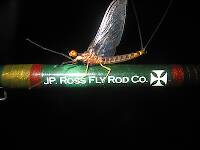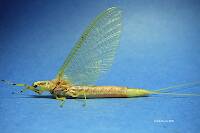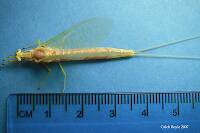
Blue-winged Olives
Baetis
Tiny Baetis mayflies are perhaps the most commonly encountered and imitated by anglers on all American trout streams due to their great abundance, widespread distribution, and trout-friendly emergence habits.
Featured on the forum

This seems to be a young larva of Limnephilus. Although not clear in the picture, several ventral abdominal segments have chloride epithelia.

Troutnut is a project started in 2003 by salmonid ecologist Jason "Troutnut" Neuswanger to help anglers and
fly tyers unabashedly embrace the entomological side of the sport. Learn more about Troutnut or
support the project for an enhanced experience here.
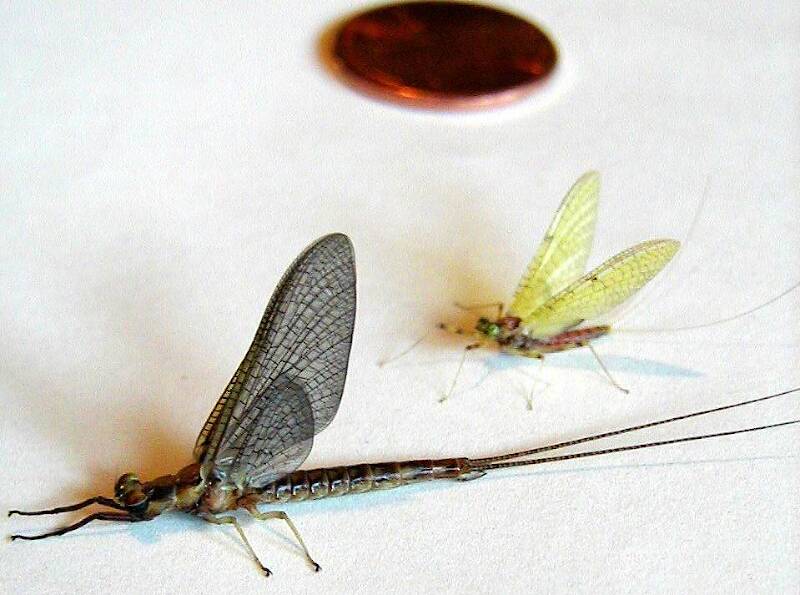
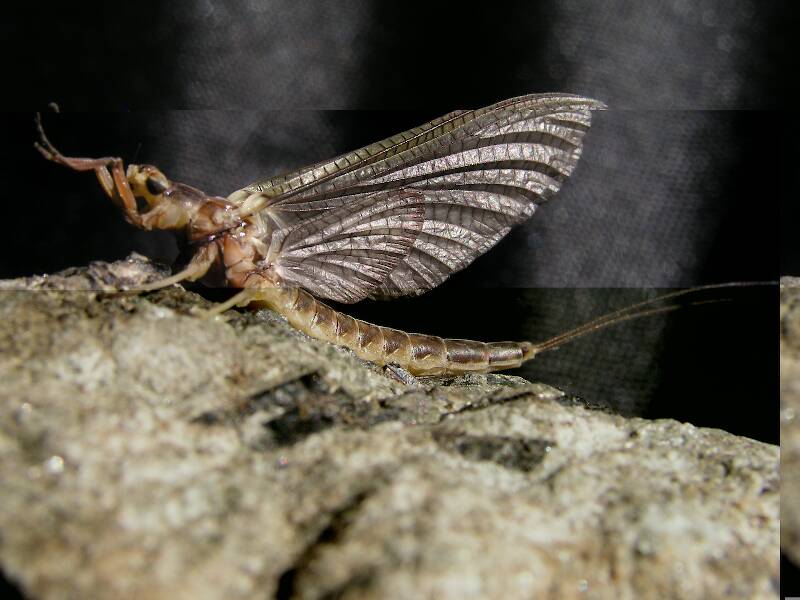
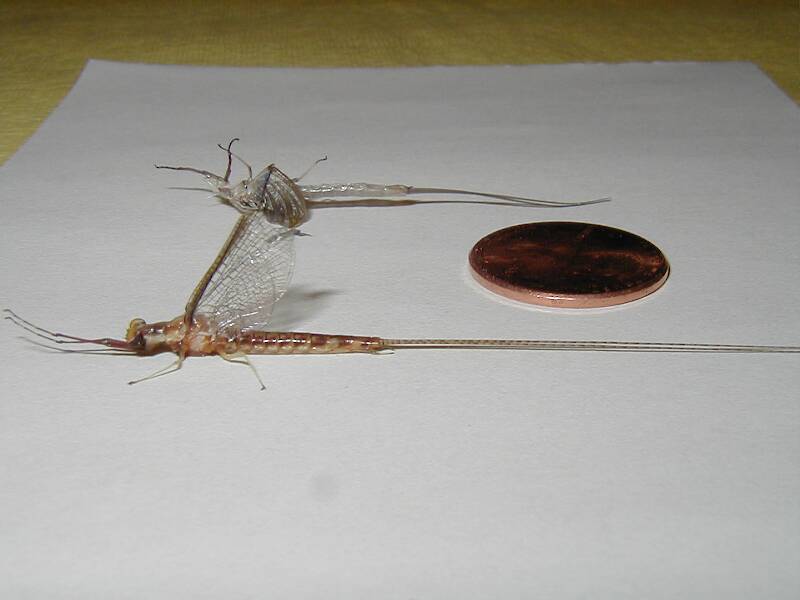
TroutNut2 on Jun 13, 2007June 13th, 2007, 9:00 am EDT
Here is a few pictures of a mayfly that I collected and we just had another "hatch" this weekend. I will try to get some better pictures this weekend if we have another hatch.
Troutnut on Jun 13, 2007June 13th, 2007, 10:12 am EDT
The big one in front is probably Hexagenia limbata (or just "Hex") and the yellow one in back is some kind of Stenacron (light cahill).
Jason Neuswanger, Ph.D.
Troutnut and salmonid ecologist
Troutnut and salmonid ecologist
Taxon on Jun 13, 2007June 13th, 2007, 11:24 am EDT
How about Isonychia bicolor and Stenacron?
Troutnut on Jun 13, 2007June 13th, 2007, 12:30 pm EDT
It's definitely Hexagenia. The markings look pretty much like limbata but I wouldn't conclusively rule out other species... that's just by far the most likely one.
Jason Neuswanger, Ph.D.
Troutnut and salmonid ecologist
Troutnut and salmonid ecologist
GONZO on Jun 13, 2007June 13th, 2007, 3:26 pm EDT
The various guises of limbata are amazing. At first glance, I would have guessed atrocaudata simply because it is so dark, but I only see limbata and rigida listed for ME. And this definitely doesn't look like rigida. From the body color of the Stenacron dun, it appears to be a female.
Wiflyfisher on Jun 14, 2007June 14th, 2007, 3:34 am EDT
Actually, isn't the male Hex limbata smaller and dark reddish brown, like the photo? When I see the darker flies they do remind of atrocaudata. I don't see atrocaudata hatching until mid to end of July and the hatch is very sparse.
John S.
https://WiFlyFisher.com
https://WiFlyFisher.com
TroutNut2 on Jun 14, 2007June 14th, 2007, 4:44 am EDT
I will try to send more pictures.
Troutnut on Jun 14, 2007June 14th, 2007, 6:08 am EDT
Yeah, the males are smaller and come in various darker shades. The wings are usually gray like this one. Here's one of mine which looks very similar to the one posted here:
http://www.troutnut.com/specimen/603
http://www.troutnut.com/specimen/603
Jason Neuswanger, Ph.D.
Troutnut and salmonid ecologist
Troutnut and salmonid ecologist
Nightfisher
Posts: 7
Posts: 7
Nightfisher on Jun 14, 2007June 14th, 2007, 7:29 am EDT
Too small for hex if that is a penny next to it. They are bigger than a silver dollar out by me.
Nightfisher
Posts: 7
Posts: 7
Nightfisher on Jun 14, 2007June 14th, 2007, 7:31 am EDT
Im guessing the big one is an iso.
Troutnut on Jun 14, 2007June 14th, 2007, 8:11 am EDT
It's a Hex. The males are usually quite a bit smaller than the females, and there's quite a bit of individual variation within populations. Also, depending on the water, they might just not grow quite as large.
Jason Neuswanger, Ph.D.
Troutnut and salmonid ecologist
Troutnut and salmonid ecologist
Nightfisher
Posts: 7
Posts: 7
Nightfisher on Jun 14, 2007June 14th, 2007, 9:38 am EDT
i dont know about that. Still say its a slate wing. I guess the big question is was it taken from hex water. Do I read things correctly that it was taken from a river in Maine? Do you guys get hex up there?
We sure get them here in Michigan. Out here it is Hex central right about now.
We sure get them here in Michigan. Out here it is Hex central right about now.
Troutnut on Jun 14, 2007June 14th, 2007, 1:29 pm EDT
Compare my pictures of Hexes to my pictures of Isonychias. The overall shape and proportions (the "look") of the two is very different. This is especially clear in the head, the prothorax (section to which the front legs are attached) and in the length and taper of the body. Isonychia also doesn't come in the color, or with the markings, of this mayfly.
Jason Neuswanger, Ph.D.
Troutnut and salmonid ecologist
Troutnut and salmonid ecologist
Wiflyfisher on Jun 15, 2007June 15th, 2007, 2:16 am EDT
I agree with Jason, it's defintely a Hex. specie of some sort. Iso's have an entirely different shape and a more solid coloration. Digital photos can be deceiving especially when displayed on different monitors as a jpg.
I just grabbed a Wisconsin Hex. male off of our porch screen and set him on a penny. The photo is sort of crappy but you will see he is not that much longer than a penny.
http://www.wiflyfisher.com/namie/male-hex.jpg
I just grabbed a Wisconsin Hex. male off of our porch screen and set him on a penny. The photo is sort of crappy but you will see he is not that much longer than a penny.
http://www.wiflyfisher.com/namie/male-hex.jpg
John S.
https://WiFlyFisher.com
https://WiFlyFisher.com
GONZO on Jun 17, 2007June 17th, 2007, 6:18 am EDT
Actually, isn't the male Hex limbata smaller and dark reddish brown, like the photo?
Right, John, though the males do vary quite a bit as well. And the atrocaudata hatch timing is usually later than limbata, with some overlap in many places. The atrocaudata often have dark staining around the rear margin of the hind wings, but this seems variable and is absent in some males I've observed. (And I often see photos identified as limbata that also have this staining.)
My most useful field ID trait for atrocaudata is to look for the dark, paired longitudinal dashes on the dorsal surface at the rear of the abdomen (between the angled hashmarks that meet the lateral midline). These paired dorsal dashes continue only faintly over the rest of the abdomen in some specimens, but they are usually very distinct on segments (7), 8, and 9. On rigida and many limbata, these marks are replaced by single, thicker dashes that form a "trident" shape in conjunction with the angled hashmarks, and can also be most prominent at the rear of the abdomen. Rigida is the palest of the three, but this alone is not a reliable distinction because limbata females can also be very pale in some locations. The shape of the "nose" in the nymphs and the distinctive shape of the male "organ" are about the only ways I know to confidently distinguish beween rigida and limbata.
Do I read things correctly that it was taken in a river in Maine? Do you guys get hex up there?
Nightfisher, although not as famous as the Midwestern activity, Maine does have good Hex hatches, as do NY, PA, and many other Eastern states. Eastern Canada also has good hatches. Limbata is a transcontinental species, contributing good Hex activity to the West and most other parts of the country. Perhaps the greatest variety of Ephemeridae species is found in the upper Southeast and Mid-Atlantic States, with four Hex species and relatives like Litobrancha, Pentagenia, and several Ephemera species contributing to a great wealth of big Ephemeridae drakes there.
Quick Reply
Related Discussions
Topic
Replies
Last Reply
3
Nov 23, 2018
by Brian314
by Brian314
69
Apr 1, 2012
by Pilonm
by Pilonm





